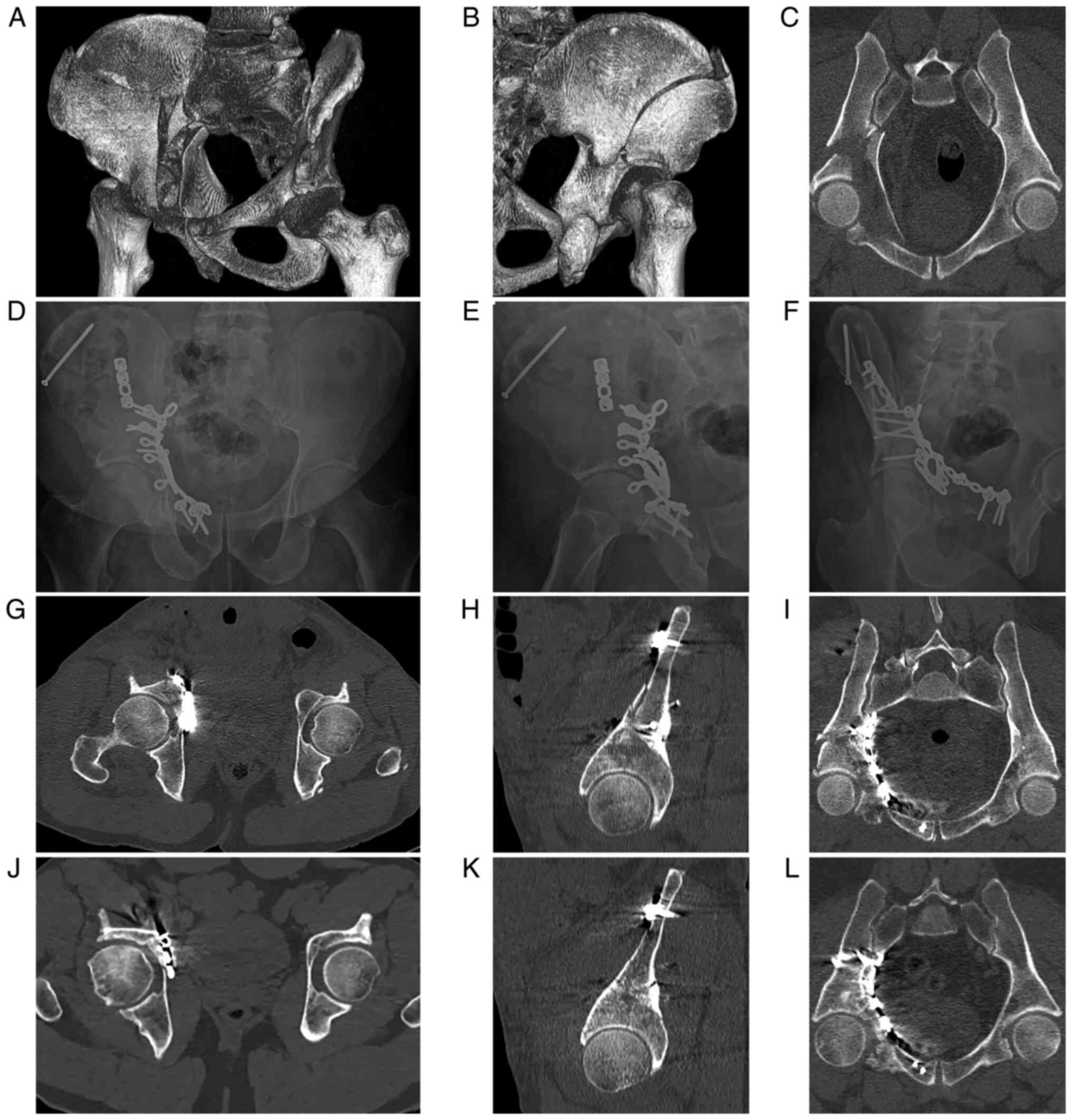|
1
|
Matta JM: Fractures of the acetabulum:
Accuracy of reduction and clinical results in patients managed
operatively within three weeks after the injury. J Bone Joint Surg
Am. 78:1632–1645. 1996.PubMed/NCBI
|
|
2
|
Judet R, Judet J and Letournel E:
Fractures of the acetabulum: Classification and surgical approaches
for open reduction. Preliminary report. J Bone Joint Surg Am.
46:1615–1646. 1964.PubMed/NCBI
|
|
3
|
Giannoudis PV, Grotz MR, Papakostidis C
and Dinopoulos H: Operative treatment of displaced fractures of the
acetabulum. A meta-analysis. J Bone Joint Surg Br. 87:2–9.
2005.PubMed/NCBI
|
|
4
|
Briffa N, Pearce R, Hill AM and Bircher M:
Outcomes of acetabular fracture fixation with ten years' follow-up.
J Bone Joint Surg Br. 93:229–236. 2011.PubMed/NCBI View Article : Google Scholar
|
|
5
|
Letournel E, Judet R and Elson RA:
Surgical approaches to the acetabulum. In: Fractures of the
Acetabulum. Elson RA (ed) Springer, Berlin, pp363-397, 1993.
|
|
6
|
Matta JM: Operative treatment of
acetabular fractures through the ilioinguinal approach. A 10-year
perspective. Clin Orthop Relat Res: Aug 1, 1994 (Epub ahead of
print).
|
|
7
|
Gaheer RS, Rysavy M, Al Khayarin MM and
Kumar K: Femoral artery intimal injury following open reduction of
an acetabular fracture. Orthopedics. 32(212)2009.PubMed/NCBI
|
|
8
|
Yamamoto N, Noda T, Saito T, Uehara T,
Shimamura Y and Ozaki T: External iliac artery thrombosis following
open reduction of acetabular fracture: A case report and literature
review. Arch Orthop Trauma Surg. 140:481–485. 2020.PubMed/NCBI View Article : Google Scholar
|
|
9
|
Badulescu O V, Filip N, Sirbu P D,
Bararu-bojan I, Vladeanu M, Bojan A and Ciocoiu M: Current
practices in haemophilic patients undergoing orthopedic surgery-a
systematic review. Exp Ther Med. 20(207)2020.PubMed/NCBI View Article : Google Scholar
|
|
10
|
Cole JD and Bolhofner BR: Acetabular
fracture fixation via a modified Stoppa limited intrapelvic
approach. Description of operative technique and preliminary
treatment results. Clin Orthop Relat Res. 305:112–123.
1994.PubMed/NCBI
|
|
11
|
Hirvensalo E, Lindahl J and Kiljunen V:
Modified and new approaches for pelvic and acetabular surgery.
Injury. 38:431–441. 2007.PubMed/NCBI View Article : Google Scholar
|
|
12
|
Andersen RC, O'Toole RV, Nascone JW,
Sciadini MF, Frisch HM and Turen CW: Modified stoppa approach for
acetabular fractures with anterior and posterior column
displacement: Quantification of radiographic reduction and analysis
of interobserver variability. J Orthop Trauma. 24:271–278.
2010.PubMed/NCBI View Article : Google Scholar
|
|
13
|
Alexa-Stratulat T, Neagu M, Neagu AI,
Alexa ID and Ioan BG: Consent for participating in clinical trials
- Is it really informed? Dev World Bioeth. 18:299–306.
2018.PubMed/NCBI View Article : Google Scholar
|
|
14
|
Taller S, Srám J, Lukáš R, Endrych L and
Džupa V: Fixation of acetabular fractures. a novel method of
pre-operative Omega plate contouring. Acta Chir Orthop Traumatol
Cech. 81:212–220. 2014.PubMed/NCBI(In Czech).
|
|
15
|
Matta JM, Mehne DK and Roffi R: Fractures
of the acetabulum. Early results of a prospective study. Clin
Orthop Relat Res. 241–250. 1986.PubMed/NCBI
|
|
16
|
D'Aubigne RM and Postel M: Functional
results of hip arthroplasty with acrylic prosthesis. J Bone Joint
Surg Am. 36-A:451–475. 1954.PubMed/NCBI
|
|
17
|
Harris WH: Traumatic arthritis of the hip
after dislocation and acetabular fractures: Treatment by mold
arthroplasty. An end-result study using a new method of result
evaluation. J Bone Joint Surg Am. 51:737–755. 1969.PubMed/NCBI
|
|
18
|
Letournel E: The treatment of acetabular
fractures through the ilioinguinal approach. Clin Orthop Relat Res.
292:62–76. 1993.PubMed/NCBI
|
|
19
|
Wu YD, Cai XH, Liu XM and Zhang HX:
Biomechanical analysis of the acetabular buttress-plate: Are
complex acetabular fractures in the quadrilateral area stable after
treatment with anterior construct plate-1/3 tube buttress plate
fixation? Clinics (Sao Paulo). 68:1028–1033. 2013.PubMed/NCBI View Article : Google Scholar
|
|
20
|
Tosounidis TH, Gudipati S, Panteli M,
Kanakaris NK and Giannoudis PV: The use of buttress plates in the
management of acetabular fractures with quadrilateral plate
involvement: Is it still a valid option? Int Orthop. 39:2219–2226.
2015.PubMed/NCBI View Article : Google Scholar
|
|
21
|
Peter RE: Open reduction and internal
fixation of osteoporotic acetabular fractures through the
ilio-inguinal approach: Use of buttress plates to control medial
displacement of the quadrilateral surface. Injury. 46 (Suppl
1):S2–S7. 2015.PubMed/NCBI View Article : Google Scholar
|
|
22
|
Qureshi AA, Archdeacon MT, Jenkins MA,
Infante A, DiPasquale T and Bolhofner BR: Infrapectineal plating
for acetabular fractures: A technical adjunct to internal fixation.
J Orthop Trauma. 18:175–178. 2004.PubMed/NCBI View Article : Google Scholar
|
|
23
|
Šrám J, Taller S, Lukáš R and Endrych L:
Use of the Omega plate for stabilisation of acetabular fractures:
First experience. Acta Chir Orthop Traumatol Cech. 80:118–124.
2013.PubMed/NCBI(In Czech).
|
















